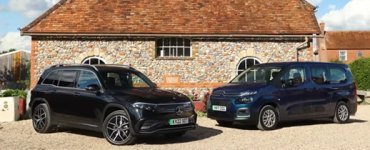When comparing the Citroën ë-Berlingo and the Mercedes-Benz EQB, several factors come into play, including price, performance, range, seating capacity, and features. Here's a detailed comparison to help you determine which electric seven-seater suits your needs:
Price:
Citroën ë-Berlingo: Starts around £32,000, making it a more budget-friendly option for families seeking an electric vehicle.
Mercedes-Benz EQB: Starts at approximately £55,000, positioning it in the premium segment with corresponding features and brand prestige.
Performance and Range:
Citroën ë-Berlingo:
Battery Size: 50 kWh
Range: Up to 174 miles on a full charge, suitable for urban and short-distance travel.
Horsepower: 134 hp
Top Speed: 81 mph (130 km/h)
Acceleration (0-60 mph): Approximately 11.5 seconds
Mercedes-Benz EQB:
Battery Size: 66.5 - 70.5 kWh
Range: Between 255 - 321 miles, offering greater flexibility for longer journeys.
Eletrifying
Horsepower: 225 hp (EQB 300) to 288 hp (EQB 350)
Top Speed: 99 mph (160 km/h)
Acceleration (0-60 mph): 7.7 seconds (EQB 300)
Seating and Space:
Citroën ë-Berlingo:
Seating Capacity: Up to seven seats, with a focus on practicality and spaciousness.
Cargo Space: Generous, especially with rear seats folded, catering to larger families and bulkier items.
Mercedes-Benz EQB:
Seating Capacity: Seven seats, with the third row more suitable for children or shorter trips.
Cargo Space: Adequate, though less than the ë-Berlingo, reflecting its compact SUV design.

Features and Equipment:
Citroën ë-Berlingo:
Interior: Functional with essential tech features, emphasizing durability and ease of use.
Infotainment: Standard system with smartphone connectivity.
Safety: Includes basic driver assistance systems.
Mercedes-Benz EQB:
Interior: Premium materials with advanced technology integration.
Infotainment: MBUX system featuring dual screens, voice control, and extensive connectivity options.
Safety: Comprehensive suite of driver assistance and safety features, aligning with Mercedes' luxury standards.
Pros and Cons:
Citroën ë-Berlingo:
Pros:
Affordability: Significantly lower price point.
Practicality: Spacious interior with flexible seating and cargo configurations.
Cons:
Limited Range: Shorter driving range may require more frequent charging on longer trips.
Performance: Modest acceleration and top speed.
Mercedes-Benz EQB:
Pros:
Extended Range: Suitable for longer journeys with fewer charging stops.
Luxury Features: High-quality interior and advanced technology.
Performance: Stronger acceleration and higher top speed.
Cons:
Price: Higher cost may be a barrier for some buyers.
Third-Row Space: Limited space in the third row compared to the ë-Berlingo.
Conclusion: The choice between the Citroën ë-Berlingo and the Mercedes-Benz EQB hinges on your priorities:
Citroën ë-Berlingo: Ideal for those seeking a cost-effective, practical, and spacious electric vehicle for family use, primarily for shorter commutes and urban driving.
Mercedes-Benz EQB: Suitable for buyers desiring a premium electric SUV experience with extended range, superior performance, and luxury features, justifying the higher price point.
Consider your budget, driving habits, and feature preferences to make the best decision for your needs.
For a visual comparison and more insights, you might find this video helpful:
Youtube
Price:
Citroën ë-Berlingo: Starts around £32,000, making it a more budget-friendly option for families seeking an electric vehicle.
Mercedes-Benz EQB: Starts at approximately £55,000, positioning it in the premium segment with corresponding features and brand prestige.
Performance and Range:
Citroën ë-Berlingo:
Battery Size: 50 kWh
Range: Up to 174 miles on a full charge, suitable for urban and short-distance travel.
Horsepower: 134 hp
Top Speed: 81 mph (130 km/h)
Acceleration (0-60 mph): Approximately 11.5 seconds
Mercedes-Benz EQB:
Battery Size: 66.5 - 70.5 kWh
Range: Between 255 - 321 miles, offering greater flexibility for longer journeys.
Eletrifying
Horsepower: 225 hp (EQB 300) to 288 hp (EQB 350)
Top Speed: 99 mph (160 km/h)
Acceleration (0-60 mph): 7.7 seconds (EQB 300)
Seating and Space:
Citroën ë-Berlingo:
Seating Capacity: Up to seven seats, with a focus on practicality and spaciousness.
Cargo Space: Generous, especially with rear seats folded, catering to larger families and bulkier items.
Mercedes-Benz EQB:
Seating Capacity: Seven seats, with the third row more suitable for children or shorter trips.
Cargo Space: Adequate, though less than the ë-Berlingo, reflecting its compact SUV design.

Features and Equipment:
Citroën ë-Berlingo:
Interior: Functional with essential tech features, emphasizing durability and ease of use.
Infotainment: Standard system with smartphone connectivity.
Safety: Includes basic driver assistance systems.
Mercedes-Benz EQB:
Interior: Premium materials with advanced technology integration.
Infotainment: MBUX system featuring dual screens, voice control, and extensive connectivity options.
Safety: Comprehensive suite of driver assistance and safety features, aligning with Mercedes' luxury standards.
Pros and Cons:
Citroën ë-Berlingo:
Pros:
Affordability: Significantly lower price point.
Practicality: Spacious interior with flexible seating and cargo configurations.
Cons:
Limited Range: Shorter driving range may require more frequent charging on longer trips.
Performance: Modest acceleration and top speed.
Mercedes-Benz EQB:
Pros:
Extended Range: Suitable for longer journeys with fewer charging stops.
Luxury Features: High-quality interior and advanced technology.
Performance: Stronger acceleration and higher top speed.
Cons:
Price: Higher cost may be a barrier for some buyers.
Third-Row Space: Limited space in the third row compared to the ë-Berlingo.
Conclusion: The choice between the Citroën ë-Berlingo and the Mercedes-Benz EQB hinges on your priorities:
Citroën ë-Berlingo: Ideal for those seeking a cost-effective, practical, and spacious electric vehicle for family use, primarily for shorter commutes and urban driving.
Mercedes-Benz EQB: Suitable for buyers desiring a premium electric SUV experience with extended range, superior performance, and luxury features, justifying the higher price point.
Consider your budget, driving habits, and feature preferences to make the best decision for your needs.
For a visual comparison and more insights, you might find this video helpful:
Youtube
